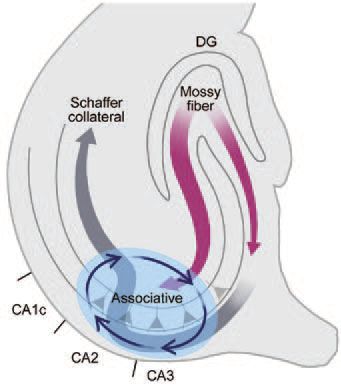
Physiology News Magazine
Brain waves plainly speaking
Recent studies of brain waves (oscillations) generated by the hippocampus reveal how a large collection of nerve cells turns into a living brain tissue. These oscillations are brain-specific integrative network activity, adopted through the collective properties of the network, and not supported by the activity of individual cells
Features
Brain waves plainly speaking
Recent studies of brain waves (oscillations) generated by the hippocampus reveal how a large collection of nerve cells turns into a living brain tissue. These oscillations are brain-specific integrative network activity, adopted through the collective properties of the network, and not supported by the activity of individual cells
Features
Yacov Fischer
Brain Research Institute, University of Zurich, Switzerland (kfischer@hifo.unizh.ch)
https://doi.org/10.36866/pn.55.27


How the brain works remains largely an inaccessible question which we, as researchers, lack the conceptions and tools to address.
However, we can deal with a manageable problem by rephrasing the question to: what characterizes the activity of the living brain, and how does it translate to the functions we assign to the brain? By solving this basic question, we are able to learn important information about the principles that govern the function of a large group of neurons as a living brain tissue, and in turn reach the position where we can think of ways to address more complex questions.
What is the most characteristic function of the brain known? The answer is straightforward – brain waves, known in scientific terms as oscillations. Indeed oscillations, a brain specific phenomenon, are a hallmark of the living brain. Since their discovery, in the late 1920s, oscillations (and the resulting EEG) have been suggested to be involved in a variety of normal activities and pathologies of the brain, and to be critical to many ‘higher’ brain functions. It is therefore conceivable that oscillations are likely to represent a basic operational principle of the brain and its organs.
Indeed, Grey Walter showed in a series of studies that were ahead of their time (1950s) that robots built to implement the biological principles of oscillations could exhibit self-awareness, consciousness, learning, recognition of other members of the group, and social behaviours.
To address the ‘old’ and ‘new’ conceptions regarding oscillations, I shall concentrate only on oscillatory activities that are related to the hippocampus. The hippocampus is particularly suitable for the study of oscillatory activity, since it is the source for theta oscillations (~8 Hz), a prominent brain wave, and contributes to the brain’s gamma activity (~40 Hz).
These rhythmicities are a brain-specific integrative network activity that is suggested to be critical to the function of this organ and of the brain. Therefore, understanding the underlying mechanisms would reveal the principles governing the integrative network function (oscillations) of the organized neuronal ensemble (the hippocampus).
‘Old’ concept
It is believed that the firing pattern of action potentials of the hippocampal cells underlies the oscillatory activity. Action potentials are an all-or-none type of signal that represent a form of a ‘decision’ at the single cell level that provides the cell with the means to communicate this ‘decision’ to other cells.
This concept, first discovered in invertebrate neurons, demonstrates that the basic principles of neuronal function are consistent throughout the species. However, in invertebrates, where the nervous system consists of a small number of neurons, the function of every neuron is critical; in the mammalian brain, where neurons are abundant, it is not necessary for every neuron to exhibit action potential firing to support their function.
‘New’ concepts
Direct measurements of the activity of individual cells of the hippocampal network show that oscillations depend on sustained synaptic activity. It is therefore reasonable to assume that a mechanism based on sustained synaptic activity underlies the EEG signal, rather than an action potential based one.
There is increasing evidence that an action potential-based mechanism does not support the sustained synaptic activity. This is because the numbers of action potentials provided by the principal cells are too low, and the properties of discharge in the inhibitory cells are not always consistent with initiation, frequency-control, synchronization and pacing of the oscillations. This is further illustrated when considering the energy constraints on the tissue, where action potentials consume a large part of the brain’s energy, and cannot be sustained at high rates for long.
Gap junctions are likely to be a critical element in the integrative function of the hippocampus to adapt an oscillatory mode of activity. This notion was brilliantly introduced in the theoretical work of Roger Traub who, without any data, connected the physical entity of the gap junction and the theoretical notions of interactions in large networks to be the element to sustain the interaction in the large network that would influence its own function. This notion is now further supported by physiological, anatomical, and pharmacological correlative data.
The hippocampal associative pathway, one of the large axonal pathways intrinsic to the hippocampus, is the core element underlying the adaptation of the oscillatory mode of activity by the hippocampal network. This pathway, originally discovered by Lorente de Nó in the 1930s, is now found to be one of the central solutions that allows the hippocampus to support an oscillatory mode of activity under physiological conditions. The pathway consists of a large collection of axonal collaterals that unlike other intrinsic pathways does not seem to convey information between different regions of the hippocampus. The mechanism underlying sustained synaptic activity is accounted for through functional activation of this pathway, action potential discharge of contributing cells, and gap junction mediated interactions. Such a mechanism, based on the principles of distributed processing in a large axonal network, formation of a reverberatory system, and existence of a random and distributed probabilistic ‘clock’, explains how oscillations are initiated, maintained, synchronized, and paced, and how specific patterns are adapted. The solution offered by such a mechanism is robust and supports the idea that the oscillations are important for the natural function of the hippocampus.
With these new concepts, we can see some of the solutions that exist at the network level to support the integrative function of the brain tissue. These are significant breakthroughs in our understanding of the brain and its function. They also demonstrate that studying the principles of integrative function in organized neuronal ensembles is a realistic approach to significantly advance our knowledge, and that neurophysiology and electrophysiology are still among the most powerful tools, when appropriately used, for studying the function of the brain.
References
Attwell D & Laughlin SB (2001). An energy budget for signalling in the grey matter of the brain. J Cereb Blood Flow & Metab 21, 1133-1145.
Fischer Y & Dürr R (2003). Inhibitory control of intrinsic hippocampal oscillations? Brain Res 982, 79-91.
Fischer Y (2004). The hippocampal intrinsic network oscillator. J Physiol 554, 156-174.
Traub RD & Bibbig A (2000). A model of high-frequency ripples in the hippocampus based on synaptic coupling plus axon-axon gap junctions between pyramidal neurons. J Neurosci 20, 2086-2093.
